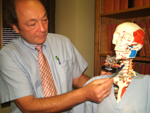Disc offers flexibility for surgery patients
by Mary Helen Yarborough
Public Relations
Patients suffering from cervical disc disease or injury now may have the option of having an artificial disc implanted instead of having the vertebrae fused after disc removal.
 Dr. John Glaser
shows the area on the body in which the artificial cervical disc would
be placed.
Dr. John Glaser
shows the area on the body in which the artificial cervical disc would
be placed.The surgery was performed for the first time at MUSC in early July. The procedure offers patients the chance of having greater flexibility in neck movements following surgery, said John Glaser, M.D., an orthopaedic surgeon who specializes in the spine. Glaser was the second to perform the procedure following the first by neurosurgeon Sunil Patel, M.D.
The device Glaser used, ProDisc-C by Synthes Spine, is one of two approved by the Food and Drug Administration. The other device is the PrestigeDisc.
“This device is a motion-sparing technology that, in the long run, may be better for some people than fusion, which eliminates all motion in the affected area,” said Glaser. “The ProDisc helps spare the residual motion and, therefore, theoretically decreases the risk of degeneration of adjacent discs.”
The artificial disc replacement, which for years has been available for lower lumbar spine therapy, would be recommended for someone who would have surgery anyway, Glaser said.
The surgery only takes about 10 minutes longer than a fusion procedure, Glaser said, and is actually easier to perform than the lumbar disc replacement which requires the surgeon to enter through the abdomen. Disc replacement in the lumbar region also requires two surgeons: a surgeon to expose the area and a spine surgeon.
“The cervical disc replacement uses the same access as the fusion,” Glaser said. The recovery time also is a little faster than other spine surgeries, because “there is no bone to heal and the patient can move earlier; maybe in a couple of weeks,” he said.
Patients that may not be suitable for the disc replacement would be those with severe arthritis in the joints of the neck and those with surgical problems at multiple levels of the neck, Glaser said. Having the artificial disc implants, though, theoretically helps reduce the risk of arthritis in patients later.
It costs about the same as surgery involving fusion, and may be covered under some insurance plans.
In a related matter, MUSC is seeking a patent on a surgical method invented by Glaser that involves plate fixation of the first cervical vertebrae (C-1). The C-1 traditionally is a difficult area in which to work, because of the proximity to the head, main arteries, and spinal nerves.
The method was presented to the Cervical Spine Society in 2006 and recently was accepted for publication in the journal Spine.
Friday, Aug. 8, 2008
Catalyst Online is published weekly,
updated
as needed and improved from time to time by the MUSC Office of Public
Relations
for the faculty, employees and students of the Medical University of
South
Carolina. Catalyst Online editor, Kim Draughn, can be reached at
792-4107
or by email, catalyst@musc.edu. Editorial copy can be submitted to
Catalyst
Online and to The Catalyst in print by fax, 792-6723, or by email to
catalyst@musc.edu. To place an ad in The Catalyst hardcopy, call Island
Publications at 849-1778, ext. 201.